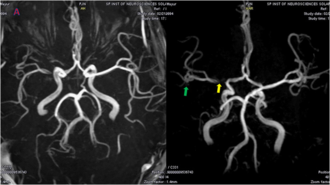Cerebral angiography
Cerebral angiography is a medical imaging technique used to visualize the blood vessels in and around the brain. This procedure is primarily used to detect abnormalities such as aneurysms, arteriovenous malformations, stenosis, and other vascular conditions.
Procedure
Cerebral angiography involves the insertion of a catheter into a large artery, typically the femoral artery in the groin. The catheter is then guided through the vascular system to the arteries in the neck that supply blood to the brain. A contrast dye is injected through the catheter, and X-ray images are taken to visualize the blood flow in the cerebral arteries.
Preparation
Before the procedure, patients may be required to undergo a series of tests, including blood tests and imaging studies such as CT scan or MRI. Patients are usually advised to fast for several hours before the procedure and may be given a mild sedative to help them relax.
During the Procedure
The patient is positioned on an X-ray table, and the insertion site is cleaned and numbed with a local anesthetic. The catheter is inserted and carefully navigated to the target area. Once the catheter is in place, the contrast dye is injected, and a series of X-ray images are taken. The entire procedure typically takes about one to two hours.
Post-Procedure Care
After the procedure, the catheter is removed, and pressure is applied to the insertion site to prevent bleeding. Patients are usually monitored for several hours to ensure there are no complications. They may be advised to avoid strenuous activities for a few days.
Indications
Cerebral angiography is indicated for the diagnosis and evaluation of various conditions, including:
- Aneurysms
- Arteriovenous malformations
- Stenosis or narrowing of the blood vessels
- Stroke
- Tumors affecting the blood vessels
Risks and Complications
While cerebral angiography is generally safe, it carries some risks, including:
- Allergic reaction to the contrast dye
- Bleeding or hematoma at the insertion site
- Infection
- Stroke or transient ischemic attack (TIA)
- Kidney damage from the contrast dye
Alternatives
Non-invasive alternatives to cerebral angiography include:
These techniques use advanced imaging technology to visualize the blood vessels without the need for catheter insertion.
History
Cerebral angiography was first developed in the early 20th century and has since evolved with advancements in imaging technology and techniques. It remains a critical tool in the diagnosis and management of cerebrovascular diseases.
See Also
References
External Links
Transform your life with W8MD's budget GLP-1 injections from $125.
W8MD offers a medical weight loss program to lose weight in Philadelphia. Our physician-supervised medical weight loss provides:
- Most insurances accepted or discounted self-pay rates. We will obtain insurance prior authorizations if needed.
- Generic GLP1 weight loss injections from $125 for the starting dose.
- Also offer prescription weight loss medications including Phentermine, Qsymia, Diethylpropion, Contrave etc.
NYC weight loss doctor appointments
Start your NYC weight loss journey today at our NYC medical weight loss and Philadelphia medical weight loss clinics.
- Call 718-946-5500 to lose weight in NYC or for medical weight loss in Philadelphia 215-676-2334.
- Tags:NYC medical weight loss, Philadelphia lose weight Zepbound NYC, Budget GLP1 weight loss injections, Wegovy Philadelphia, Wegovy NYC, Philadelphia medical weight loss, Brookly weight loss and Wegovy NYC
|
WikiMD's Wellness Encyclopedia |
| Let Food Be Thy Medicine Medicine Thy Food - Hippocrates |
Medical Disclaimer: WikiMD is not a substitute for professional medical advice. The information on WikiMD is provided as an information resource only, may be incorrect, outdated or misleading, and is not to be used or relied on for any diagnostic or treatment purposes. Please consult your health care provider before making any healthcare decisions or for guidance about a specific medical condition. WikiMD expressly disclaims responsibility, and shall have no liability, for any damages, loss, injury, or liability whatsoever suffered as a result of your reliance on the information contained in this site. By visiting this site you agree to the foregoing terms and conditions, which may from time to time be changed or supplemented by WikiMD. If you do not agree to the foregoing terms and conditions, you should not enter or use this site. See full disclaimer.
Credits:Most images are courtesy of Wikimedia commons, and templates, categories Wikipedia, licensed under CC BY SA or similar.
Contributors: Kondreddy Naveen, Prab R. Tumpati, MD

